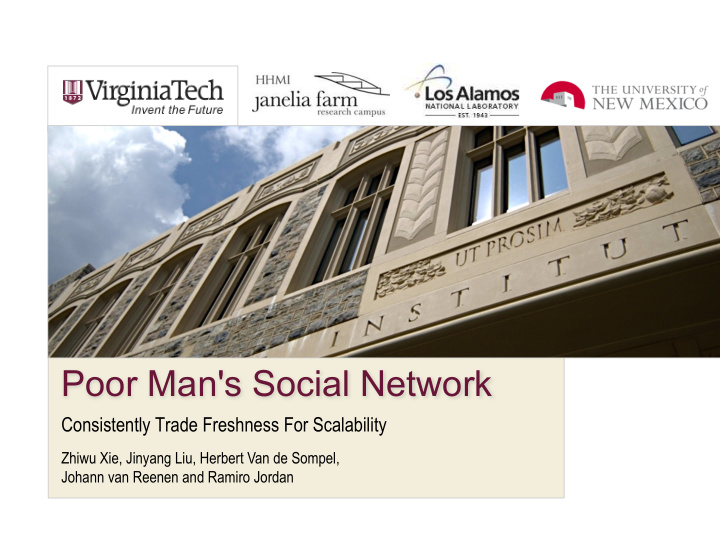



Poor Man's Social Network Consistently Trade Freshness For Scalability Zhiwu Xie, Jinyang Liu, Herbert Van de Sompel, Johann van Reenen and Ramiro Jordan
Outline • Scaling feed following • Algorithm • Experiment and results • Conclusions 2
Feed Following producer B C blah A D Feed Following: blah blah blah blah blah blah G E F consumer H blah J K consumer producer I 3
Feed Following Scalability Give me the 20 most recent tweets sent by all the people I follow • Individualized queries • Fast changing global state • Partitioning, replication, and caching • NoSQL: trade consistency for scalability 4
Consistency • Atomicity, Linearizability, or One-copy Serializability (1SR) Feed Following: blah blah blah blah blah blah blah blah Feed Following: blah blah blah blah Time 5
Retweet Anomaly Feed Following: Retweet: blah blah B Feed Following: Retweet: blah blah A C 6
New Approach: TimeMap Query Who have created new tweets during the past scheduled release periods? • Global time across partitions • Schedule releasing • Client-side processing and caching • Consistently trade freshness for scalability 7
CAP Theorem • Preconditioned on the asynchronous network model: the only way to coordinate the distributed nodes is to pass messages • In the partially synchronous model, where global time is assumed to be available, CAP may indeed be simultaneously achievable most of the time 8
Global Time • “One of the mysteries of the universe is that it is possible to construct a system of physical clocks which, running quite independently of one another, will satisfy the Strong Clock Condition.” – Time, Clocks and the Ordering of Events in a Distributed System, by Leslie Lamport 9
Scheduled Release Algorithm Who have created new tweets during the past scheduled release periods? 10
Partitioning: Send A New Tweet 0 1 2 4 3 User_id: 1, User_id: 2, User_id: 3, User_id: 4 User_id: 0, 6, 11, 16, … 7, 12, 17, … 8, 13, 18, … 9, 14, 19, … 5, 10, 15, … 11
Partitioning: TimeMap 0 1 2 3 N-1 …… …… 12
Client Side Processing If the current time is 1:05:37PM, please tell me who (no matter if I follow any of them or not) have sent new tweets from 1:05:30PM to 1:05:35PM. I’ll figure out by myself if any of these new tweets are relevant to me, and if so, I’ll retrieve these A tweets separately by myself. Cache! If the current time is 1:05:39PM, please tell me who (no matter if I follow any of them or not) have sent new tweets from 1:05:30PM to 1:05:35PM. I’ll figure out by myself if any of these new tweets are relevant to me, and if so, I’ll retrieve these B tweets separately by myself. 13
Staleness vs. Latency Fresh, but 1 hour latency I’m fine (as of 2:00) How are you? 1:00 2:00 Time 10 minutes stale but only 5 I was fine (as of 12:55) How were you at minutes latency 12:55? 1:00 1:05 Time 14
Trade Freshness For Scalability • Mass transit system vs. private car • Lose flexibility, but gain overall efficiency by sharing resources • Stale up to the length of the schedule release period, e.g., 5 seconds. 15
Experiment • Implemented on AWS • A Twitter like feed following application • Server side: Python/Django, PostgreSQL, PL/pgSQL • Client side: emulated browser, implemented in Python/Django and PostgreSQL 16
Experiment: Configurations • Used ~ 100 cloud instances from Amazon • Most are used for emulated browsers • 3 to 6 c1.medium as servers • Use memcached to simulate caches 17
Experiment: Workload • Work load similar to the Yahoo! PNUTS experiment • A following network of ~ 200,000 users • Synthetic workload generated by Yahoo! Cloud Serving Benchmark 18
Experiment Result: Query Rate 19
Experiment Result: Latency 20
Experiment Results: Caching 21
Experiment Results: CPU Load Server Client 22
Conclusions • Consistently scale feed following • Linear scalability • Practical low cost solution 23
Thank You • Questions? 24
Recommend
More recommend